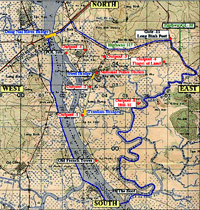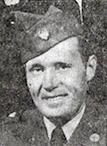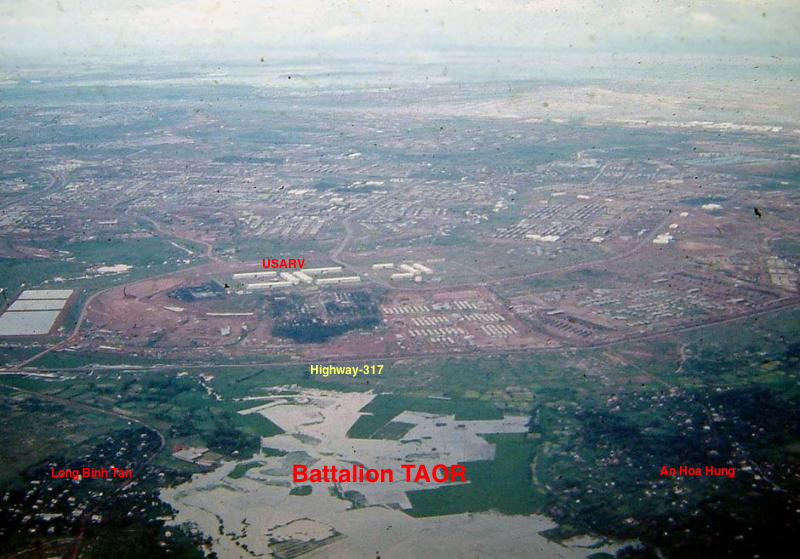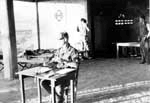The Post TET New Years Offensive II Field Forces alerted the Battalion to the date of the attack and plans were formulated to repress it. II Field Force positioned the bulk of its local organic Infantry and armored units, 199th Light Infantry Brigade, 1st Infantry Division, and 11th Armored Cavalry Regiment (Blackhorse), in positions in which the 1968 Tet Offensive attack was launched, to the north and west of Long Binh Post, leaving the security for the southern perimeter of the post to B Company.
22 February B Company strengthened all four outpost's and River Patrols, four of its five Ambush Squads, and alerted A & C Company to place their Reaction Teams on standby. Battalion acquired a platoon of C Company, 5th Battalion, 199th Light Infantry Brigade (waterborne), and assigned it to security at the Dong Nai River Bridge with its landing craft.
Four of the five B Company ambush teams were given missions to disrupt the enemy ground attack along the eastern end of the TAOR, the fifth, Squad-75 was held on post in reserve. Squad-76 was sent to Hill-15 in the most remote part of the TAOR, Squads 74, 77 & 78 were assigned to separate positions along the crest of the Finger Of Land.
23rd of February, 0200 Hours A Battalion of the 274th Viet Cong Main Force Regiment, 5th NVA Division launched their attack through the TAOR. It began with 122 mm rocket and heavy mortar attack fired from south of the Buong River, and followed by sapper team and ground assaults on Gates 10 & 11. The ambush squads were at first surprised by the intensity of the attack but soon settled down to their missions. Squad 76 directed counter fire suppressing the enemy rocket and mortar sites. The squads along the Finger were instrumental in disrupting enemy travel to reinforce the initial thrust that was being repulsed along the perimeter, identified targets and assisted in directing massive air and artillery response on the enemy ground units observed moving through their area.
By the next morning the enemy attack was crushed and and sweep operations were launched along Highway 317 and the Finger Of Land. Held in reserve through the night, Ambush Squad-75 was sent to the area of Gate-10 where the were surprised by an entrenched platoon of well armed enemy hidden along a small hill next to a Buddhist Monastery. The point man was severely wounded when the ambush was sprung,and thee others were wounded in the successful fight to recover him. Four Sherman tanks from B Troop of the 11th Armored Cavalry arrived to assist, and were stopped by the accurate onslaught of heavy machinegun fire, grenades and RPG's. Cobra gunship's arrived and finally cleared the trench. The clean up operation found 31 enemy dead.
On Hill-15 Squad-76 who spent the night under continuous sniper fire by enemy elements on Little Hill-38 across the Buong River to their south and in the wood lines to the north and east of their position, were reinforced by the platoon of infantry from C Company, 199th Light Infantry Brigade who responded from their security detail at Dong Nai River Bridge. The squad who were out of M-60 ammunition replenished their supply as the infantry platoon conducted a sweep around the base of the hill. During the sweep an RPG fired from Hill-38 missed the landing craft by only a few feet wounding one of the crewmen. Further fire was ended by the crafts 50 cal. machinegun and the M-60 of Squad-76. The platoon supported by the MP squad started a sweep from the hill north towards the Ben Go River. Along the way they killed and captured several enemy troops.Two MPs and the Scout Dog were extracted by a Dust Off due to heat stroke and dehydration.
On the Finger Of Land another Troop from the 11th Cavalry spearheaded a sweep from Gate-11 towards the Buddhist Monastery. Ambush teams 74, 77, & 78 who spent the night on the land mass were consolidated and lead by CPT Jimmy Rich their Company Commander, joined the the sweep supporting the armored spearhead. Small pockets of enemy resistance were met along the way resulting in the capture of several wounded POW's and another large body count. One cavalry trooper was wounded in the sweep operation.
At the conclusion of the sweeps a total of 131 enemy dead and their weapons were removed from the field. The enemy positions were cleared, and the Battalion reaction force supported by an infantry company and elements of the 11th Armored Cavalry set up a defensive perimeter along the northeastern perimeter of the TAOR. B Company elements were kept on post to rest and resupply.
The night of the 24th Ambush Squad-76 was again assigned to secure Hill-15 and set up an observation post. When they were dropped off by boat north of the hill they came under immediate enemy mortar fire. The Viet Cong mortar fired two volleys of three rounds at the squad before they identified its location as on the top of Hill-15. A mortar team of the 1st Infantry Division positioned on the western end of the Finger Of land returned fire silencing the enemy tube. Squad-76, who suffered no wounded from the attack, were withdrawn and repositioned in a rice mill further north until daylight when the were sent back to search the hill.







































